The last remaining claim by the gospel writer, is that these events occurred during the days of Herod the King. This is an unequivocal statement that places the events within a larger politico-historical context.
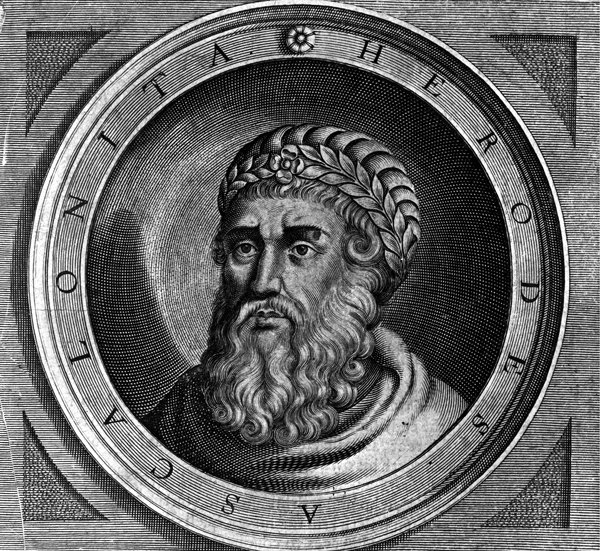 Image courtesy of wikimedia commons
Image courtesy of wikimedia commons
Herod, known as The Great, was the Idumean Jew that reigned as a vassal king over Judea and surrounding areas. He has been described as "a madman who murdered his own family and a great many rabbis", "the evil genius of the Judean nation", "prepared to commit any crime in order to gratify his unbounded ambition", and "the greatest builder in Jewish history". He is known for his colossal building projects throughout Judea, including his expansion of the Second Temple in Jerusalem (Herod's Temple), the construction of the port at Caesarea Maritima, the fortress at Masada and Herodium.” (See https://en.wikipedia.org/wiki/Herod_the_Great )
Herod’s malevolence is well documented by Flavius Josephus in his Complete Works. Herod is therein described as having executed members of his own family to remove the potential for usurpation. Josephus summation is telling: “a man he was of great barbarity towards all men equally, and a slave to his passion; but above the consideration of what was right; yet was he favoured by fortune as much as any man ever was, for from the private man he became a king; and though he were encompassed with ten thousand dangers, he got clear of them all, and continued his life to a very old age; but then, as to the affairs of his family and children, in which, indeed, according to his own opinion, he was also very fortunate because he was able to conquer his enemies; yet, in my opinion, he was herein very unfortunate.” (See Josephus, Antiquities of the Jews, Book XVII, Chapter VIII : 1)
Dating the Birth of Christ
James E Talmage, in his book Jesus the Christ, (available as a free download at Gutenberg Project) records the following:
“THE TIME OF THE BIRTH OF JESUS The time of the Messiah’s birth is the subject upon which specialists in theology and history, and those who are designated in literature ‘the learned’, fail to agree. Charles F Deems (The Light of the Nations, page 28), after giving careful consideration of the estimates, calculations and assumptions of men who have employed many means in their investigation and reach only discordant results says: ‘It is annoying to see learned men use the same apparatus of calculation and reach the most diverse results. It is bewildering to attempt a reconciliation of these varying calculations.”
In an appended note the same author states: ‘For example: the birth of our Lord is placed in BC1 by Pearson and Hug; BC2 by Scalinger; BC3 by Beronius and Paulos; BC4 by Bengel, Wieseler, and Greswell; BC5 by Usher and Petavius; BC6 by Strong, Luvin, and Clark; BC7 by Ideler and Sanclemente.’”
This description remains an accurate summary of the state of scholarly opinions on this question. An internet search today shows the divergence of views, although the hegemonic view is in favour of 4BCE. In this post we examine one of the pillars of scholarly opinion on the subject. We will see that it appears to be premised on an error.
The Dionysian System
The division of the Western historical record into the period before Christ and that after his birth, is a practice that commenced already from the second century CE. The division was standardised and regularised by a Roman Catholic monk named Dionysius Exiguus in 525AD.
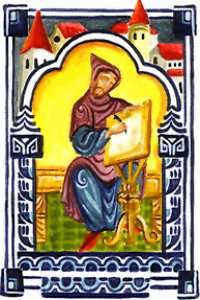
He is remembered for two achievements: his introduction of the Anno Domini system, and prognostications about the incarnation of Christ. In the latter regard, and apparently in an attempt to tie back the first Christmas, being by then, 25 December 1BCE, to a date nine months preceding it, he speculated that Christ was conceived on 25 March 1BCE.
Some predecessors of Dionysius, including Clement of Alexandria (c. 190) and Eusebius of Caesarea (c. 320) had placed the incarnation (that is the date of conception rather than the date of birth) of Christ in the year we now label 2BCE (which corresponds with the findings of this study), but by the sixth century and for several hundred years thereafter, the date of incarnation had shifted to a date 9 months before 25 December 1 BCE.
Today, the weight of modern scholarly opinion is against 25 December as the date of the birth of Christ; and the incarnation of Christ is largely ignored.
The Polish historian, Laurentius Suslyga (1570-1640), was the first to suggest that Christ was born in approximately 4BCE, a claim made in his 1605 thesis, and which he derived from chronologies provided in relation to Herod the Great, his son Philip the Tetrarch and the daughter of Augustus Caesar, Julia (see https://en.wikipedia.org/wiki/Laurentius_Suslyga ).
The renowned astronomer, Johannes Kepler (1571-1630), was Suslyga’s contemporary. He was also a diligent student of the Jewish historian Josephus, who had recorded that an eclipse of the moon had happened shortly before Herod’s death which in turn preceded the Jewish Passover. He set about determining whether a lunar eclipse that preceded the Passover near the candidate dates for the death of Herod could be found. Using impressive mathematical calculations, he found an eclipse that occurred on 13 March 4BCE, being shortly before the Passover of that year, and he dated the death of Herod to that period. He consequently threw in his not inconsiderable weight behind the thesis advanced by Suslyga.
Probably because of the influence of Suslyga’s work, and his own preference for the Jupiter/Saturn “great conjunctions” in 7 BCE as the Star of Bethlehem, Kepler missed or ignored two other proximate lunar eclipses, the first happening on 10 January 1BCE, and the second occurring on 29 December 1BCE. In either event, he did not have the power of computing that we have today, and could not get a sense of what the eclipses looked like.
The eclipse of 13 March 4BCE occurred between 01:00 and 03:00, which means that it would not have been widely observed. It was only a partial eclipse, darkening an unimpressive 20% of the moon, but this is no matter: an eclipse is an eclipse for the purpose of our enquiry; Josephus does not tell us what kind of eclipse occurred.
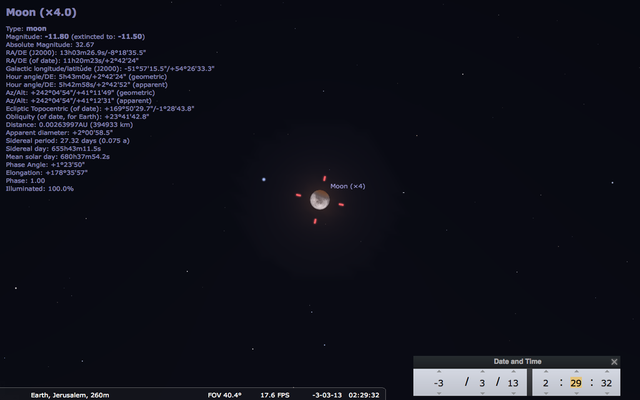
The eclipse of 10 January 1 BCE is a truly magnificent eclipse, being a total eclipse in which the moon was turned a deep blood red, as seen from Jerusalem and its surrounds. However, it occurred between midnight and 2am and is unlikely to have been seen by many people in the circumstances.
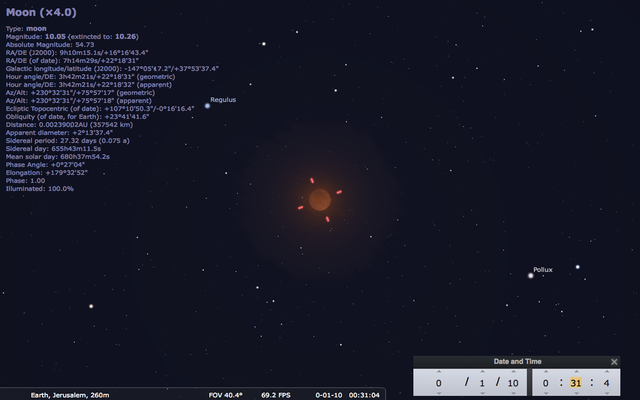
The eclipse of 29 December 1BCE was also only a partial eclipse, occluding nearly half of the moon. But in contrast to the other two candidate eclipses, this eclipse occurred while the moon was rising in the half-light of dusk, when the greater majority of people would have observed its aspect. This is particularly so since the trait of the moon was more keenly observed at the time of its rising, than at any other time.
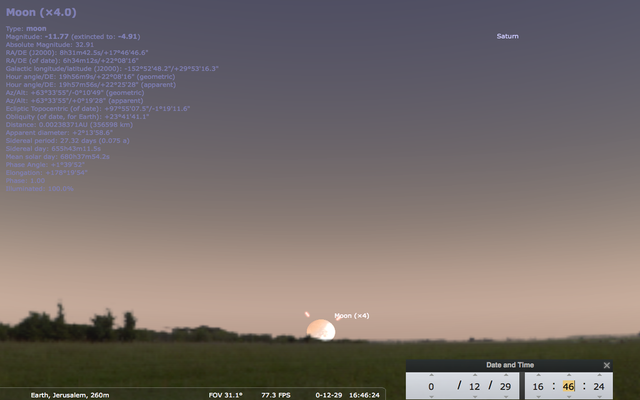
After I had identified these latter two eclipses using Stellarium, I discovered that the mathematician and astronomer, John Pratt, as far as I can tell, was the first to propose this last eclipse as another potential eclipse that Josephus might have been referring to (See John P. Pratt, "Yet Another Eclipse for Herod," The Planetarian, 19 (Dec. 1990): 8-14.)
The analysis of Suslyga, carrying with it the immense status of Kepler’s implied approval, has been extraordinarily resilient on this particular question, even though it relies upon an inconclusive basis for determining the reign (or events within a lifetime) of the individual that is used as the marker. That basis is the frequent inability of the modern scholar to know whether the chronology included or excluded the first and last year in its counting. This is a continuing problem even today. For example, the legal arena relies upon legislated conventions that either include the first and the last day/month/year; include the first and exclude the last; or exclude both the first and the last. It is difficult to be certain which of the conventions applies to the particular ancient chronology being examined. There certainly was no uniformity between historians. And consequently it is immensely challenging to achieve scholarly consensus: the date may be anything from 1 to 3 years out on this ground alone.
However, if we hold Josephus consistent, then he does not support a death date for Herod in 4BCE, and the various chronological redactors that rely upon him, do so in error.
The renowned historian Flavius Josephus covers a long period of Jewish history in his book, Antiquities of the Jews. Book XVII covers a period of 14 years “from Alexander and Aristobulus’ death to the banishment of Archelaus”, including the period when Herod dies. He does not give us a particular date that we can conclusively tie back to the Julian or Dionysian calendars, but In chapters VI to X of Book XVII, he situates the death of Herod within a number of contextual facts that can be closely examined for the purposes of dating.
In chapter VI, Josephus describes how Herod fell ill in the 70th year of his age (see Josephus, Antiquities of the Jews, Book XVII, Chapter VI : 1).
“And as he despaired of recovering as he was now about the 70th year of his age, he grew fierce, and indulged the bitterest anger upon all occasions; the cause whereof was this, that he thought himself despised, and that the nation was pleased with his misfortunes, besides which he resented a sedition which some of the lower sort of men incited against him, the occasion of which was as follows:” (emphasis added)
This sedition occurred during a Jewish festival, we are told, and was instigated by two “most eloquent men among the Jews” named Judas and Matthias, most likely Pharisees. They led their followers to tear down and hack to pieces “a large golden eagle, of great value” which the King had erected, without the approval of the greater body of the Jews, over the Great Gate of the temple. One can easily visualise Herod's attempt at syncretisation between Rome and the Yahvistic religion that this undertaking involved.
This “graven image” was no doubt offensive to members of the Pharisaical order, and the insurrection that occurred, was driven by a zeal that was fanned by the particular religious festival that marked it. No fewer than 40 of the young men who had engaged in this sedition presented themselves as martyrs for their cause, proclaiming boldly that what they had done was consistent with the will of God. Their courageous confessions could not have been more offensive to Herod and detrimental to their survival:
“ ‘Yes,’ said they, ‘what was contrived we contrived, and what hath been performed we performed it; and that with such a virtuous courage as become men; for we have given our assistance to those things that were dedicated to the majesty of God, and we have provided for what we have learned by hearing the Lord; and it ought not to be wondered at, if we esteem those laws which Moses had suggested to him, and were taught to him by God, and which he wrote and left behind him, more worthy of observation than thy [being Herod’s] commands.’”
The men thus boldly confessed and hastened their deaths (see Josephus, Antiquities of the Jews, Book XVII, Chapter VI : 2 and 3).
Following their trial, which was summary, Josephus records that their executions were marked by an ominous lunar eclipse:
“But Herod … burnt the … Matthias who had raised the sedition, with his companions, alive. And that very night there was an eclipse of the moon.”
In a footnote in modern editions of Josephus, it is recorded-
“This eclipse of the moon (which is the only eclipse mentioned by Josephus) is of the greatest consequence for the determination of the time for the death of Herod and Antipater, and for the birth and entire chronology of Jesus Christ. It happened March 13th in the year of the Julian period 4710 and the fourth year before the Christian era.”
As will be seen, this assertion is not on safe ground.
The next events described by Josephus are highly relevant to the question under consideration. Because Herod was aware that he was so hated, and fearing that nobody would mourn his death, and perhaps still chewing on the aftertaste of the execution of the seditionists, he ordered that “all the principal men of the entire Jewish nation wheresoever they lived should be called to him”. These he resolved to have locked up in a hippodrome, and to have murdered by soldiers, immediately upon his death, for “He desired … that he shall have the honour of a memorable mourning at his funeral.” If the Jewish nation did not mourn him, there would nevertheless be mourning.
As he was giving these orders, letters arrived from Rome with news of the execution of one of Herod’s enemies, named Acme, and authorisation from Caesar to execute judgment over his then imprisoned son, Antipater, as he saw fit.
“When Herod heard this, he was somewhat better out of the pleasure he had from the contents of the letters, and was elevated at the death of Acme, and that the power that was given him over his son; but, as his pains were become very great, he was now ready to faint for want of something to eat; so he called for an apple and a knife for it was his custom formerly to pare the apple himself, and soon afterwards to cut it, and eat it. When he had got the knife, he looked about and had a mind to stab himself with it.” (emphasis added).
His suicide is prevented by the timely intervention of his first cousin, Achiabas. On the same occasion, his self-loathing reaching crescendo, he commands his subjects “to kill Antipater without any further delay” (See Josephus, Antiquities of the Jews, Book XVII, Chapter VII : 1). His servants oblige him and his son is executed.
In Chapter VIII, it is recorded that, having attended to certain of his affairs, Herod
“…died, the fifth day after he had caused Antipater to be slain; having reigned, since he had procured Antigonis to be slain, 34 years; but since he had been declared king by the Romans, 37.
The mention of this chronology is what gives rise to the differences of opinion: historians do not know whether these years include or exclude the first and/or the last years; neither can they be certain whether the years are calendar years or 12 month periods. This partially explains the range of dates for the birth of Christ that scholars disagree upon.
Josephus continues to describe the manner in which those who had been shut up in the hippodrome were released, without being killed, following the appointment, and timely intervention, of Archelaus as interim governor (See Josephus, Antiquities of the Jews, Book XVII, Chapter VIII : 2-3). As to Archeleaus’ response to Herod’s death:
“Now Archelaus paid him so much respect, as to continue his mourning to the seventh day … and left off his mourning he went up into the temple.”
Archeleaus then goes to the temple to address the Jewish leaders. An interview with the people is described which results in a series of negotiations and demands, as are to be expected with the change of a governor, including a demand by the Jewish people that the people be offered the opportunity to mourn the late lamented Matthias, through a formal funeral. This was a bridge too far and Archelaus refused. Unsurprisingly it resulted in the outbreak of further civil unrest which Archelaus crushed by force of arms.
The next key event describes the time when Archelaus left for Rome:
“Now, upon the approach of that feast of unleavened bread, which the law of their fathers had appointed for the Jews at this time, which feast is called the Passover” [Archeleaus departed for Rome].
This statement bears the footnote as follows:
“This Passover, when the sedition here mentioned was moved against Archelaus, was not one, but thirteen months after the eclipse of the moon, already mentioned.”
As we shall see they have no basis to make this statement other than a desire to fit the chronology with the selection of the incorrect eclipse that others have made.
The sequence reported by Josephus is thus the following:
- a Jewish festival, at which the Matthias-led rebellion occurs;
- the trial and execution of Matthias coinciding with an eclipse of the moon;
- further instructions and directions issued by Herod relating to the genocide against the Jewish leaders and principal men;
- Herod’s attempted suicide at the time of eating an apple;
- his killing of Antipater;
- his death five days later;
- a period of seven days mourning during which Archeleaus ascends Herod’s throne;
- a transition period including negotiations between the Jews and the Romans;
- a second uprising and its suppression; and
- Archelaus’ departure for Rome prior to the Passover.
There are three reasons why the eclipse on 13 March 4BCE is clearly incorrect.
The first is hinted at by the commentators note quoted above. There is simply not enough time for the events described by Josephus following the eclipse, to have occurred by the date of the Passover of that year, 11 April 4BCE. The Josephus redactors, who opt for Archelaus’ departure thirteen months later, concede this. But in doing so, they stretch out the events most uncomfortably. Selecting this eclipse as the marker for the death of Herod makes the events either too compressed or too stretched out.
 Image at www.motherearthnews.com
Image at www.motherearthnews.com
Interestingly, the clearest indication that the 13 March 4BCE date is incorrect is the passing reference to Herod eating an apple. It is an agricultural reality that it is not possible for there to have been an edible apple available in Jerusalem as late as some time after 13 March 4BCE. This is on account of the fact that the last of the apples would have been harvested during September of the preceding year. It would be difficult to extend the shelf life of such an apple, given the absence of refrigeration, for a period of 3 to 4 months. It is impossible for it to have been extended to a date in excess of 6 months. Even a king would not to be able to find an edible apple, more than six months after the last of the apples would have been harvested.
Thirdly, there is not a Jewish festival that fits the dates proposed for 4BCE. The feast immediately prior to Passover is Purim, or the feast of Esther. However, this occurred on 10 March 4BCE, which does not give enough time for the sedition, arrest, trial and execution of the men within 3 days.
There is, therefore, good reason why the safest synchronising of the chronologies used by the previous scholars, ignoring the question of the eclipse, is an estimate for the death of Herod between 2BCE and 1CE. (See for example, Gerard Gertoux, “Dating the Death of Herod”, in a Scientific approach to an absolute Chronology through Synchronisms dated by Astronomy. His preference is for a death date in January 1BCE. However, his analysis demonstrates why 4BCE does not fit, while the 29th of December meets all of his criteria equally as well as the eclipse on 10 Jan 1BCE.)
There are also good reasons why the 1BCE eclipses are better fits; they are the following.
 Image at cdn.history.com
Image at cdn.history.com
Given the reason for the sedition, Hanukkah, also known as the festival of lights or feast of dedication, is the most likely festival to have inspired the uprising. Hannukah is an 8-day festival commencing on 25 Kislev, to commemorate the rededication of the Second Temple in Jerusalem at the time of the Maccabean Revolt. During this period of time, according to 1 Maccabees, a single vial of consecrated oil, usually only enough to burn for one night, miraculously burned for 8 days, the time needed to supply a fresh source of kosher oil. It would have been this festival, of all the Jewish festivals, that would have inspired and directed the zeal of the young men toward a “cleansing” of the temple and the removal of the symbol of their pagan ruler’s power erected within their holy precinct. This festival occurred from 3 - 11 December in 2 BCE and 14-22 December in 1BCE. As we have seen above, the festival of Purim not only does not fit the time available, but is not the kind of festival that would have triggered the uprising.
There are at least three reasons why the eclipse on 29 January 1BCE is the better of the two 1BCE candidates.
• Hanukkah in 2 BCE gives a month before the eclipse on 10 January 1 BCE, which is too long for the swift execution that Josephus describes; the seven days between 22 December and 29 December 1BCE is a better fit of the available time and the summary trials and executions that the rioters received.
• Similarly to the eclipse of 13 March 4BCE, the eclipse of 10 January 1BCE, occurred between midnight and 02:00, and was unlikely to have been widely observed, for all its beauty, except possibly by astronomers. By contrast, the eclipse of 29 December 1BCE was an early evening eclipse and would have been widely observed and reported on; and consequently more likely to have been regarded as an ominous mark by the Jews, still smarting from the execution of their insurrectionists.
• 29 December 1BCE is the closer of the eclipses for the sake of edible apples.
We can therefore propose the following chronology relative to the death of Herod, with reference to the sequence recorded by Josephus:
- a Jewish festival, at which the Matthias-led rebellion occurs: Hanukah, ending 22 December 1BCE;
- the trial and execution of Matthias coinciding with an eclipse of the moon: between 22 December 1BCE and 29 December 1 BCE;
- further instructions and directions issued by Herod relating to the genocide against the Jewish leaders and principal men: 30 December 1BCE;
- Herod’s attempted suicide at the time of eating an apple : 30 December 1BCE;
- his killing of Antipater 31 December 1BCE;
- his death five days later: January 1CE;
- a period of seven days mourning during which Archeleaus ascends Herod’s throne: Mid-January 1CE;
- a transition period including negotiations between the Jews and the Romans;
- a second uprising and its suppression: February/March 1CE; and
- Archelaus’ departure for Rome prior to the Passover: Passover occurred on 27 March 1CE.
This chronology supports a death date for Herod in January 1CE. As we have seen, this is at least four months after the coming of the Magi, and permits enough time for their visit, escape and the massacre of the innocents in Bethlehem. The latter event coincides well (although it must be pointed out finds no mention in Josephus’ work) with the fevered and fanatically insecure state of mind that Herod displayed at the time. He saw plots at every turn that took him so far as to kill his own son, days before his own death.
We have seen in this post that there is an objectively verifiable death date for Herod as late as 1CE. This permits the astronomic sequence to have played itself out “in the days of Herod the King”, as the author of Matthew claims.
In the next and final post in this series we will review the full proposed chronology of events relative to the star of Bethlehem, and the events it heralded; and consider the implications of this study.
A word to the sponsors: thanks for the up votes my posts have received. Thanks to @gavvet for featuring me. If you have been interested in what I have been writing, please consider following me - I don’t know when I will have overstayed my welcome on @gavvet featuring page, but it can’t be long now. In addition to future posts on astronomy, I will write about life, family, law, philosophy, politics, religion, hiking, the occasional book review; and whatever else tickles my fancy!
don't forget to follow @vuyusile
Wow! Very scholarly. Thanks.
Downvoting a post can decrease pending rewards and make it less visible. Common reasons:
Submit
Thank you!
Downvoting a post can decrease pending rewards and make it less visible. Common reasons:
Submit
This guy gets it!
Downvoting a post can decrease pending rewards and make it less visible. Common reasons:
Submit